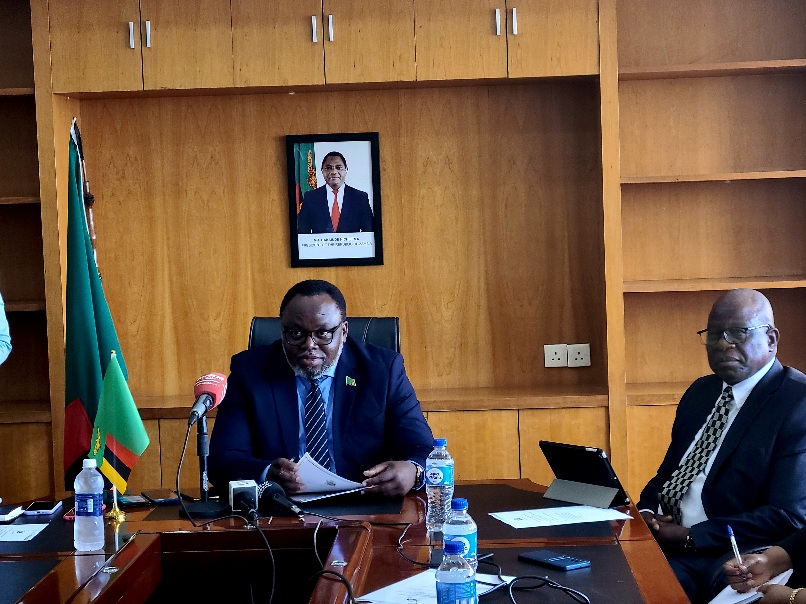Resilient and Rising
 Kabuswe says, Capital investment and reforms is lifting Zambia’s mining fortunes.
Kabuswe says, Capital investment and reforms is lifting Zambia’s mining fortunes.By Francis Maingaila
Lusaka, Zambia24 - (14 August 2025) - The Zambian mining sector continues to register strong growth, with Konkola Copper Mines (KCM) achieving an extraordinary 4,000% surge in output over the past year despite obstacles such as declining ore grades and energy limitations—a performance that Minister of Mines and Minerals Development Paul Kabuswe says demonstrates the industry’s resilience, robust overall production, and promising long-term outlook.
Addressing journalists, Kabuswe stressed that the sector remains on an upward path even though several mines have yet to reach optimal output levels.
“The issue is not that production has collapsed. We simply have not attained the peak of our capacity. Once these mines operate at full potential, we will witness even greater expansion,” he said.
Copper Output Surges
According to Kabuswe, the Total copper production in Q2 2025 climbed to 439,644.29 metric tons from 373,263.9 metric tons in the same quarter last year—an increase of 17.78%.
He said Artisanal and small-scale miners contributed 39,477.8 metric tons, representing 9% of cumulative output for the first half of the year.
He said the increase was mainly driven by higher production from KCM, Mopani Copper Mines, Kansanshi, and Chibuluma Mine. KCM’s output skyrocketed from 880.73 metric tons in Q2 2024 to 35,387.91 metric tons this year, while Mopani’s production rose 60.38% to 27,406.21 metric tons.
In contrast, SINO Metals Leach saw a 50.87% decline following a dam failure, while FQM Trident’s production fell 22.72% due to lower ore grades. Mimbula and Sino Xinyuan also reported decreases.
Other Minerals: Gains and Setbacks
Gold output rose 35.93% to 1,777.62 kg, driven mainly by Kansanshi Mine.
Nickel production dropped 20.66% to 9,570.23 metric tons due to pit wall remediation at FQM Trident and reduced output at Munali Nickel Mine. Emerald production fell 16.19% to 11,382.77 kg.
Kabuswe credited regulatory reforms and increased artisanal and small-scale mining (ASM) activity for the gains in major copper production.
Socio-Economic Contributions and Investments
He commended KCM for its record-breaking performance and noted its $8.2 million investment in local road infrastructure as an example of mining’s broader economic impact.
Strong leadership and sound management, he said, are essential for reviving underperforming operations.
“Restoring production takes time, but swift interventions are vital to safeguard the economy,” Kabuswe stated.
Energy Security and Government Measures
Energy supply remains a critical factor for mining.
Kabuswe explained that policy measures—including diversification of the energy mix to include more solar power and enabling firms to import electricity—have ensured that no mine has had to shut down due to power shortages.
He expressed optimism about the industry’s trajectory:
“If we maintain this momentum over the next three to four years, production and related economic activities will improve substantially.”
Policy and Legal Frameworks
The minister confirmed that the Minerals Regulation Commission Act of 2024 and the Geological and Minerals Development Act of 2025 are now in full effect, with operational frameworks being implemented.
To combat illegal mining, the Ministry has issued 1,488 artisanal mining rights—1,176 to individuals and 312 to cooperatives—engaging an estimated 4,296 Zambians.
Zambia Gold Company Limited (ZamGold) has so far purchased 13.9 kg of gold from ASMs in Rufunsa and Mumbwa, averaging 84% purity.
Plans to modernize ASM include partnerships with investors and the rollout of a Pit Side Manual to enhance safety standards.
Licensing and Geological Surveys
The Ministry’s digital licensing platform, ZIMIS, launched in February 2025, is being upgraded following early challenges, with operations temporarily reverted to the Trimble Folio System.
Mining license issuance increased sharply to 560 in Q2 2025, up 42.49% from 393 last year, with exploration and processing licenses showing the largest gains.
The Countrywide High-Resolution Aerial Geophysical Survey (CHRAGS) has now mapped 27.6% of Zambia, generating updated geological data to attract investors and curb illegal mining.
Major Capital Commitments
Mopani Copper Mines, in partnership with International Resources Holdings (IRH), has invested USD 1.1 billion, increased its workforce to 13,058, and worked with 4,926 Zambian suppliers, paying USD 93 million in 2025 and settling USD 106 million in outstanding 2024 obligations.
KCM, fully operational across four business units, employs 13,811 workers. Since August 2024, it has invested USD 395 million, with a further USD 206 million earmarked for 2025.
"Priority projects include the Konkola Deep Mining Project, underground rail upgrades, and raise boring technology. Of its 2,495 registered suppliers, 1,983 are Zambian-owned businesses," he said.
Outlook
Kabuswe concluded that the first half of 2025 presents a strong positive outlook for the mining sector, reaffirming its role as a key driver of Zambia’s economic transformation under President Hakainde Hichilema.



Comments
Post a Comment